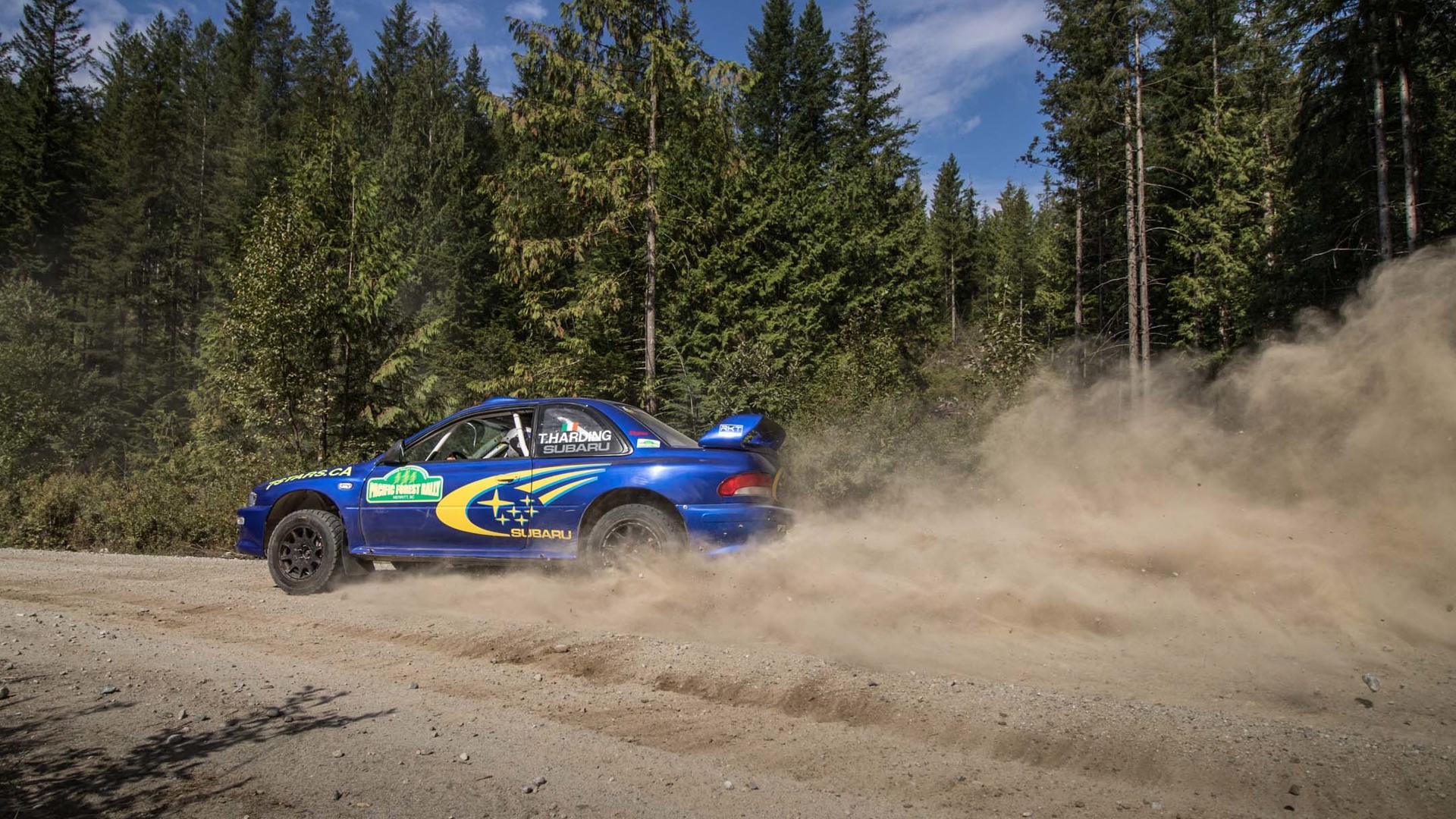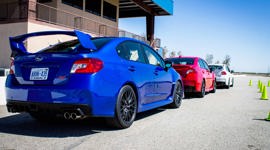Trevor Harding lives for rally. A former Irish national rallying champion from Tipperary, the wiry Harding drives as fast as he talks, with a hard-charging style reminiscent of his rally hero, Colin McRae. McRae is one of three names the Irishman carries on his helmet, and Harding speaks respectfully of the time he met Subaru’s iconic rally legend, before running against him at the famous Moll’s Gap stage in Kerry.
But even as Harding relates being tongue-tied at meeting his hero for the first time, he’s soon off and running again, talking about past opportunities to go toe-to-toe with “the big noises”, and take the fight to better-sponsored drivers. When he made his Canadian debut at Big White in 2014, he was able to pilot his 1991 Legacy to a podium finish. “It’s not that I’m superstitious at all,” he says. “Just that I’ve always had the best success in my career with a Subaru. Now I’ve got the right kind of car again.”

The car in question is sure to be a fan favourite when it debuts at this year’s Pacific Forest Rally at the end of September. A World Rally Blue GC8-chassis Impreza, it’s been built to Open Class specification and fitted with a 22B-style widebody kit by RKT Motorsports out of New York state. It’s a shape that any Subaru fan will immediately recognize, the best of the Impreza STI breed, and a tribute to the golden age of WRC.
Today, on a closed forestry road north of Mission, BC, there are no spectators, only trees and gravel. There’s no closed trailer and no tent for the service area. Instead, the ground on which we unload the freshly decal-ed Subaru is littered with old shotgun casings, evidence of a little backwoods target practice.

“You’re not supposed to shoot this close to roads anymore,” Harding muses, giving one of the shells a kick. He grins. “But there’s the law – and then there’s rednecks.”
Fifteen minutes later, the forest rings to the deafening crack-crack-crack of anti-lag, and the bright blue rally car goes spearing out into the woods, surfing a wave of gravel. Stones clatter off the thick skid-plating, the sequential gearbox fills the stripped-out cabin with metallic whine, and the machine slides through a hairpin between exposed rock and steep drop-off. Harding hauls on the handbrake, yanks the sequential shifter for a quick downshift, then gets on the throttle as the Impreza scrabbles for traction, then leaps forward towards the crest of a hill.

Like many others, Harding left Ireland after the economic downturn in the late-2000s dried up many jobs. He landed in Australia, but found it less open than expected. Canada, on the other hand, was basically a clean slate. “There’s so much opportunity here,” he says, “even in the way the banks operate. And the people are so much friendlier.”
By day, he works at a used car dealership called Seven Stars, selling everything from pre-owned Audis to Ferraris. He also currently runs a small rally school, and has plans to expand it into a full tarmac and gravel facility some day. Harding will also rents out rally cars, with instruction included, and builds them to sell.
“I started building rally cars because I couldn’t really find what I wanted here,” he says. “Then when I had some success in the Legacy, someone made me an offer I couldn’t refuse, and it was onto the next one. At home [in Ireland] I was always robbing Peter to pay Paul to get into the next car, and so I had the chance to drive some pure class machines. Even an ex-McRae N555!”

However, all of it – the day job, the instruction, the rally-car flipping – is all just the hustle required to chase the passion. Canadian rally is unique in that it exists outside the mainstream of public view, but is surprisingly accessible when compared to conventional motorsports. Competing in something like Porsche’s GT3 Cup is a huge investment, limited to gentleman racers and those with significant corporate backing. Rally belongs to the scrappers, the grassroots battlers, the ones who won’t stop chasing the dream.
In that respect, Subaru Canada’s repositioning of its rally strategy provides a great service for drivers like Harding. Instead of a single factory team that dominating every race, Subaru now provides contingency sponsorship to any Subaru that starts out on a sanctioned Canadian Rally Championship (CRC) event. Finish in the top six Subarus, and there’s additional money to be had, with a final payout for the top Subaru finishers in this year’s CRC championship.

Harding estimates the cost of competing in a full weekend of rally, including instruction, car rental, and consumables like tires and fuel, at around $8,000. Defray that cost with a strong finish and a payday, and you’re looking at competing in a national championship event over three days for about the cost of attending a tarmac driving school.
Further, that’s just looking at things logically, and logic isn’t what rally is about. Few other sports put such emphasis on driver skill, especially on the snow stages. A fast car is important, but more important is the ability to control a car that’s hurtling along a serpentine ribbon of gravel, with unyielding trees whipping past your window, and chunks of rock just waiting to claw out some vital suspension component.

Then there’s just how much fun it is. If road-racing is chess, then rally is surfing. It’s riding the edge, trusting your luck, catching the slides, anticipating the unexpected as best you can, and then closing out the day with a bunch of like-minded lunatics, deep in the woods around a campfire.
“Once you’ve tasted champagne sprayed while standing on the hood,” Harding grins, “it’s hard to go back.”
But it’s not just about chasing victory. Rally isn’t the trophies on the shelf, it’s the pursuit, the drive to see how far you can push yourself. Rallying isn’t just what you look to achieve, for drivers like Trevor Harding, it’s a way of life.




















